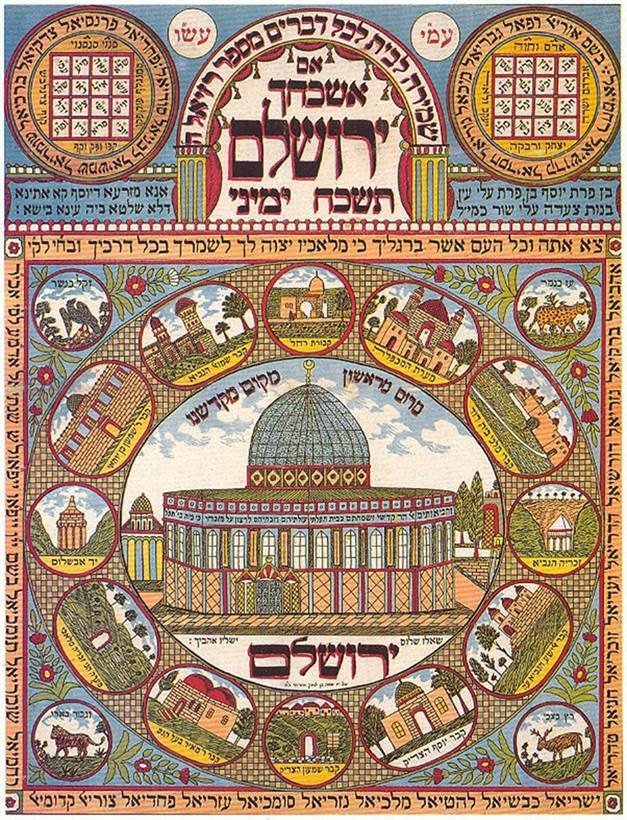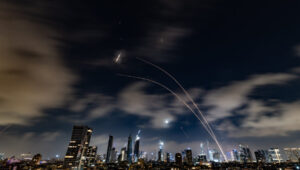That is a question many find hard to comprehend. What is a picture of the Al-Aqsa Mosque on Jerusalem’s Temple Mount doing on Jewish religious articles? To site a few examples, on a wall in the Abuhav Synagogue, a 15th-century synagogue in Safed Israel, the decorative cloth used to cover the braided Shabbat bread bears a depiction of the iconic golden-domed mosque. Likewise, one can find the shrine of Islamic worship depicted in a Passover Haggadah from the Middle Ages. The practice was limited to the years before the founding of the State of Israel. What motivated Jews to depict Islamic symbols in the synagogue?
Elisaf Tel-Or who oversees management and development for the Meitarim School Network in which 14,000 secular and religious children study together in 137 schools with the goal of increasing understanding among the diverse Jewish communities in Israel recently addressed this strange contradictory phenomenon. Tel-Or describes the Abuhav synagogue in Safed where the central dome just above the Holy Ark of the Torah portrayed the Dome of the Rock in beautiful colors. Jews who read from the Torah scroll on Shabbat and bowed towards Jerusalem had the Islamic shrine highlighted right before their eyes. One would think that a painting or reproduction of Solomon’s Temple would find its place within the walls of a synagogue, but no, it’s the Islamic Mosque on the Temple Mount.
When the Abuhav Synagogue was renovated, the Dome of the Rock above the ark was painted over with new Jewish motifs because the mosques on Jerusalem’s Temple Mount now symbolize the heated conflict between Israel and the Arab-Muslim world. But this was not the case hundreds of years ago. Historically, Muslims understood and did not mind the fact that the Jewish Temple once stood where the Dome of the Rock now stands. This is well documented in numerous Islamic scriptures and sources. This then explains, why back then Jews had no problem depicting the Islamic shrine even in Jewish holy places and on ceremonial religious articles.
Many art scholars are of the opinion that Christians began depicting the Dome of the Rock in Jerusalem on the maps of Israel with the designation “Temple of our Lord,” meaning the “Temple of Jesus.” The famous map of a Franciscan monk from 1590 is the best example of this, and there are many other maps of this type.

This is best understood as an attempt by medieval Christian artists to portray historical works and symbols that reflect the time they lived in and not the historical truth. That said, these Christian artists created naive paintings that completely ignore the historical gap between past and present, an ignorance about the Jewish history of Jerusalem that has continued until this day.
Tel-Or disagrees. “This explanation (above) can be applied to works from the late Middle Ages and the beginning of the Modern Era, but does not explain why Jewish artists in the late 19th and early 20th centuries continued to include the Dome of the Rock in their works.” Tel-Or points to various works of the Jewish artist Moshe Ben Yitzhak Mizrachi, who was born in Tehran in 1870 and immigrated to Israel 20 years later yet still places the Dome of the Rock central to his Jewish art. “At that time, the artist was conscious of his choice, and painters were not creating paintings that corresponded to the present but were striving for objective historical truth. They had long since understood that it makes no sense to depict the Dome of the Rock as a ‘Jewish temple,’” Tel-Or points out.

Tel-Or’s conclusions are based on a theological view that a “holy place” is an expression meant to shatter any sentiments we might have that we are in control of and can occupy anything in this world. Holy places are sacred, beyond human control and they are intended to make a demonstration of our human limitations. This concept is supported by the fact that the High Priest could only enter the “Holy of Holies” just once a year. Likewise, Moses found God in a misty cloud on Mount Sinai, a holy place where all boundaries and self-confidence are blurred.
The painting of the Dome of the Rock described as the “site of the temple” was a sign to Tel-Or. “We do not rule the world and neither do other religions,” is the way he sees it. According to Tel-Or these Islamic depictions in synagogues express the complexity of the Jewish-Muslim paradox. “This holy place in Jerusalem stands above man and even above Jewish or Arab nationality and yet two nations claim Jerusalem as their own. The solution is not to divide Jerusalem, because Jerusalem belongs to God first. Jerusalem is ‘extraterritorial,’ it is God’s property, not man’s.”















